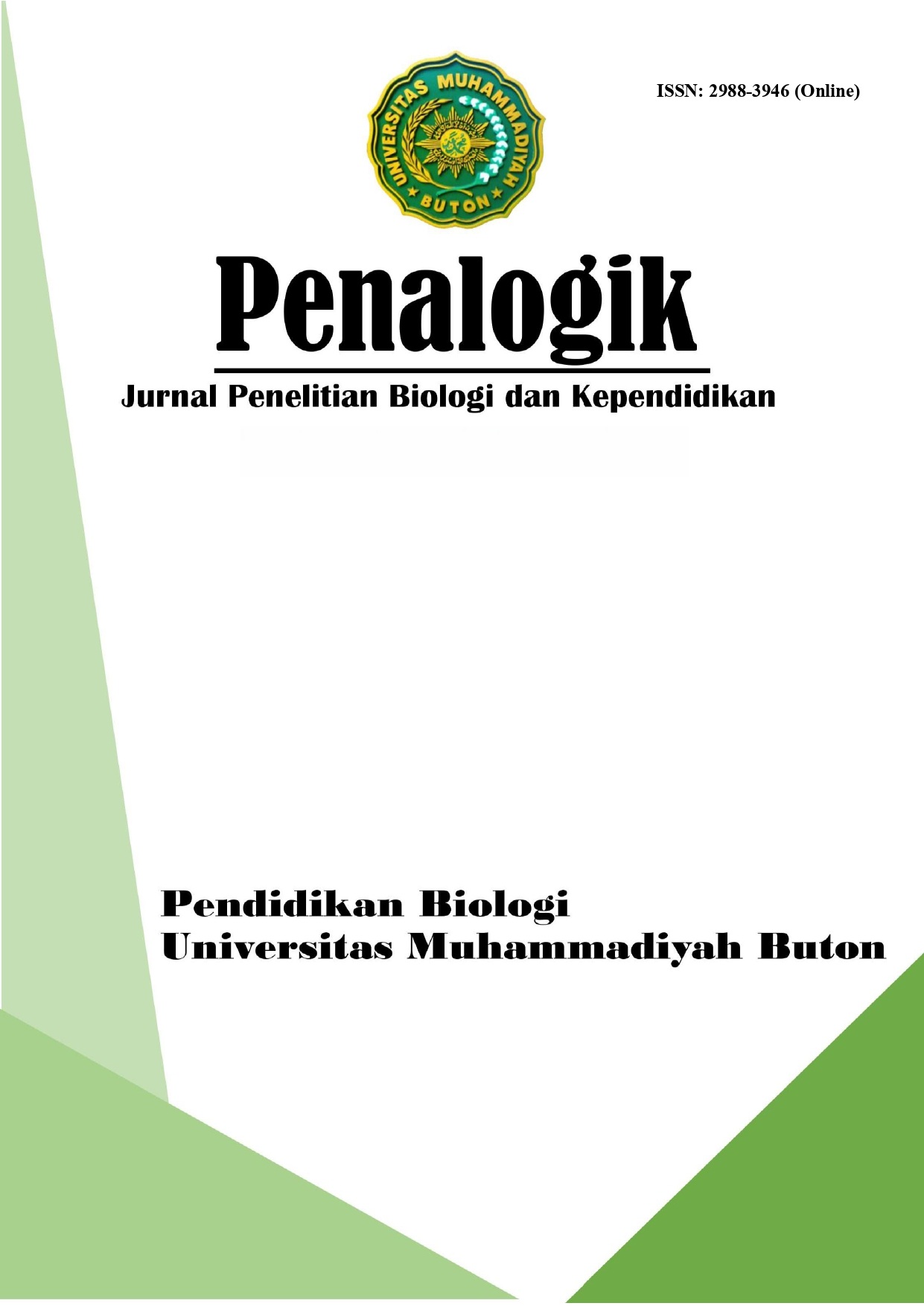Karakterisasi Morfologi Jenis-jenis Bambu di Kelurahan Wakoko Kabupaten Buton
DOI:
https://doi.org/10.35326/penalogik.v3i2.7635Keywords:
Kelurahan Wakoko, Kabupaten Buton, Karakterisasi Morfologi, Jenis-jenis BambuAbstract
Bambu merupakan salah satu tanaman bernilai ekologis dan ekonomi tinggi yang banyak tumbuh di wilayah pedesaan dan telah lama dimanfaatkan oleh masyarakat. Indonesia memiliki sekitar 10% dari total jenis bambu dunia, dengan 50% di antaranya bersifat endemik. Penelitian ini bertujuan untuk mengidentifikasi dan mengkarakterisasi morfologi jenis-jenis bambu yang tumbuh di Kelurahan Wakoko, Kabupaten Buton. Metode yang digunakan adalah deskriptif kualitatif dengan pendekatan eksploratif. Data dikumpulkan melalui observasi langsung terhadap karakter morfologi tanaman dan pengukuran parameter lingkungan. Hasil penelitian menunjukkan bahwa terdapat delapan spesies bambu dari empat marga yang ditemukan, yaitu Gigantochloa robusta, Gigantochloa pseudoarundinacea, Gigantochloa apus, Schizostachyum brachycladum, Schizostachyum blumei, Bambusa glaucophylla, Bambusa blumeana, dan Dendrocalamus asper. Setiap spesies menunjukkan perbedaan morfologi pada karakter rumpun, rebung, batang, pelepah buluh, percabangan, dan daun. Hasil pengukuran lingkungan menunjukkan suhu tanah 27–30°C, kelembapan udara 70–80 dan pH tanah netral. Kondisi ini menunjukkan bahwa wilayah Kelurahan Wakoko mendukung pertumbuhan bambu secara optimal. Penelitian ini memberikan informasi dasar yang penting untuk mendukung konservasi dan pemanfaatan bambu lokal secara berkelanjutan.
Downloads
References
Adil, Z., Sidabutar, H., Susilo, C., & Justisia, A. (2014). Studi Permintaan Pasar untuk Produk-produk Bambu dan Penilaian tentang Teknologi-teknologi Memproses Bambu. Badan Revitalisasi Industri Kehutanan (BRIK).
Akinlabi, E. T., Anane-Fenin, K., & Akwada, D. R. (2017). Bamboo Taxonomy and Distribution Across the Globe. In Bamboo (pp. 1–37). Springer International Publishing. https://doi.org/10.1007/978-3-319-56808-9_1
Ali Saudagar, I., Kumar Mehra, V., Gupta, T., Kumar Sonkar, M., Maravi, S., & Shirin, F. (2022). Variation in Morphological Characters of Leaf and Culm Sheath of Bambusa vulgaris Schrad. ex.Wendl. in Central India. International Journal of Plant & Soil Science, 1005–1017. https://doi.org/10.9734/ijpss/2022/v34i242730
Cai, X., Gao, T., Zheng, S., Jiang, R., Zhang, Y., Rong, J., He, T., Chen, L., & Zheng, Y. (2023). Effects of Enclosure Succession on the Morphological Characteristics and Nutrient Content of a Bamboo Whip System in a Moso Bamboo (Phyllostachys edulis) Forest on Wuyi Mountain, China. Forests, 14(11), 2193. https://doi.org/10.3390/f14112193
Ervianti, D., Widjaja, E. A., & Sedayu, A. (2019). Bamboo diversity of Sulawesi, Indonesia. Biodiversitas Journal of Biological Diversity, 20(1), 91–109. https://doi.org/10.13057/biodiv/d200112
Evy Aryanti, H. T. M. (2016). Identifikasi Bambu pada Daerah Aliran Sungai Tiupupus Kabupaten Lombok Utara. Jurnal Biologi Tropis, 16(2), 23–36. https://doi.org/10.29303/jbt.v16i2.221
Febriyanti, F., Kandowangko, N. Y., & Ahmad, J. (2023). Identification Morphology of Bamboo, and Traditional Use in Gorontalo. Jurnal Biodjati, 8(2), 347–364. https://doi.org/10.15575/biodjati.v8i2.29714
Hu, T., Kong, L., Hu, S., Deng, M., Yang, G., Wei, Q., & Yu, F. (2023). Emerging Insights into the Roles of the Rhizome–Culm System in Bamboo Shoot Development through Analysis of Non-Structural Carbohydrate Changes. Plants, 13(1), 2. https://doi.org/10.3390/plants13010002
Irawan, B., Ihsan, M., Permana, M. D., & Noviyanti, A. R. (2025). A Review of Bamboo: Characteristics, Components, and Its Applications. Journal of Natural Fibers, 22(1). https://doi.org/10.1080/15440478.2025.2522928
Siddik, M. (2023). Analisis Rantai Nilai dan Nilai Tambah Komoditas Bambu sebagai HHBK Unggulan Pulau Lombok Nusa Tenggara Barat-Indonesia. AGROTEKSOS, 33(1), 64. https://doi.org/10.29303/agroteksos.v33i1.806
Wang, Z., Dai, F., Yue, X., Zhong, T., Wang, H., & Tian, G. (2023). Identification and Recognization of Bamboo Based On Cross-Sectional Images Using Computer Vision. Wood and Fiber Science, 55(1), 43–52. https://doi.org/10.22382/wfs-2023-06
Widjaja, E. A., & Karsono, K. (2005). Bamboo Diversity in Sumba Island. Biodiversitas Journal of Biological Diversity, 6(2). https://doi.org/10.13057/biodiv/d060205
Yang, D., Li, J., Wang, S., Yu, L., Zhan, H., & Ma, Y. (2023). Abnormalities in Stamen and Ovary Development Responsible for Low Seed Set of Dendrocalamus hamiltonii Nees et Arn. ex Munro. Forests, 14(12), 2282. https://doi.org/10.3390/f14122282
Zha, R., Chen, T., Liu, Q., Wei, Q., & Que, F. (2023). Morphological and Anatomical Analysis of the Internodes of a New Dwarf Variant of Moso Bamboo, Phyllostachys edulis f. exaurita. Plants, 12(9), 1759. https://doi.org/10.3390/plants12091759
Zhang, Q., Chu, X., Gao, Z., Ding, Y., Que, F., Ahmad, Z., Yu, F., Ramakrishnan, M., & Wei, Q. (2024). Culm Morphological Analysis in Moso Bamboo Reveals the Negative Regulation of Internode Diameter and Thickness by Monthly Precipitation. Plants, 13(11), 1484. https://doi.org/10.3390/plants13111484
Zhao, W., Lv, Z., Zhang, H., Yue, J., Zhang, X., Li, L., Huang, F., & Lin, S. (2024). Anatomical Mechanisms of Leaf Blade Morphogenesis in Sasaella kogasensis ‘Aureostriatus.’ Plants, 13(3), 332. https://doi.org/10.3390/plants13030332
Zhao, X., Zhao, P., Zhang, Z., Zhu, L., Hu, Y., Ouyang, L., Ni, G., & Ye, Q. (2017). Culm Age and Rhizome Affects Night-Time Water Recharge in the Bamboo Phyllostachys pubescens. Frontiers in Plant Science, 8. https://doi.org/10.3389/fpls.2017.01928
Zhuo, J., Vasupalli, N., Wang, Y., Zhou, G., Gao, H., Zheng, Y., Li, B., Hou, D., & Lin, X. (2023). Molecular identification of Bambusa changningensis is the natural bamboo hybrid of B. rigida × Dendrocalamus farinosus. Frontiers in Plant Science, 14. https://doi.org/10.3389/fpls.2023.1231940





